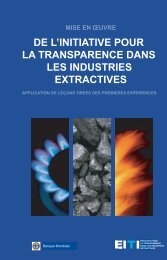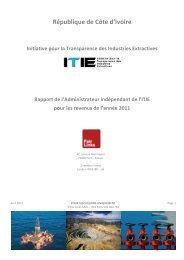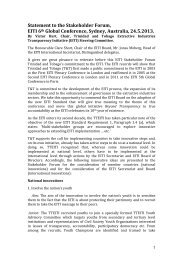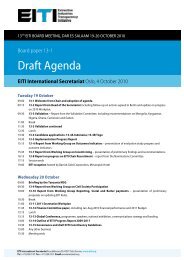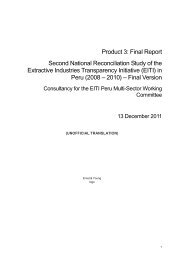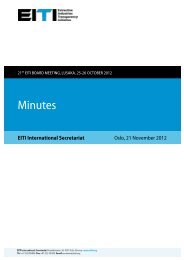Vietnam feasibility study - EITI
Vietnam feasibility study - EITI
Vietnam feasibility study - EITI
You also want an ePaper? Increase the reach of your titles
YUMPU automatically turns print PDFs into web optimized ePapers that Google loves.
capital investment and usually process raw materials, while the national scale companies exploit<br />
various kinds of minerals with a high capital investment. Examples of these latter companies<br />
are the <strong>Vietnam</strong> National Chemical Group (Vinachem); <strong>Vietnam</strong> Cement Industry Corporation<br />
(Vinacem); <strong>Vietnam</strong> Oil and Gas Group (Petrovietnam); and <strong>Vietnam</strong> National Coal - Mineral<br />
Industries Group (Vinacomin). Vinacomin produces about 43 million tons of coal per year and has<br />
an annual average total sale of 57,000 1 billion VND (2.98 billion USD) (Xa Luan, 2009).<br />
• The private owned enterprise: this group includes the limited and joint venture companies that<br />
operate mainly in exploiting and processing building materials and in recollecting metal minerals<br />
on a small scale. This group has a high number of companies, though their technological and<br />
financial capacity is often limited. Recently, some private companies are able to explore and<br />
exploit some mines at a medium scale.<br />
• The foreign invested enterprises mostly operate in the exploiting and processing minerals for the<br />
cement industry, such as Nghi Son, Chinfon, Lask <strong>Vietnam</strong> cement company; in exploiting ashlars<br />
paving stone, such as Latina An Giang, Yabashi, Carbonate Calcium YBB Joint Stock company; and<br />
in extracting mineral water, such as Lavie (Le, 2008).<br />
• Collective, individual and household enterprise: this group often operates in exploiting and<br />
processing normal building minerals, such as stone and sand on a tiny scale and is usually only<br />
able to serve local demand.<br />
the role of local communities<br />
Mining activities cause huge negative impacts on the environment in mining areas. It is difficult to rehabilitate<br />
the environment. Obviously, the local people are daily impacted by and suffer from these mining activities.<br />
Natural resources with a variety of high trade value in the market inspire people and organizations inside<br />
and outside the mining area to exploit in all forms, both secretly and openly, both legal and illegal. A lot of<br />
pressure is placed on natural resources from many sides, especially local communities.<br />
According to the law, the role of local communities is indispensable in mining activities. They are the<br />
people who live near the natural resources. They have the track conditions and indigenous knowledge.<br />
Benefits from natural resources are really sticking directly and regularly with local communities so<br />
that they will be often forces to protect, preserve and promote. Local communities are ears and eyes<br />
as well as the core force of government in all activities, as well as contribute to the development of<br />
sustainable resources.<br />
the role of social organizations<br />
Currently, the organizations led by the Fatherland Front (Farmers Association, Women Union, Youth<br />
Union, Veterans Association), civil society organizations, non-governmental organizations and some<br />
other organizations are playing an increasingly important role in the protection and development<br />
of natural resources. These organizations through consultation and support of the authorities have<br />
gradually shown their power in protecting natural resources. These organizations support law<br />
enforcement to people and reflect the aspirations of people to the authorities. In addition, these<br />
organizations have the role of social communication to raise awareness about environmental<br />
protection for people in and outside of the mining areas. These organizations also play a critical role in<br />
natural resource monitoring and evaluation through daily activities.<br />
*1: 1US$ is equal to 19,100 VND (exchange rate in January, 2010).<br />
The Extractive Industries Transparency Initiative and the Implementation Perspective of <strong>Vietnam</strong><br />
21



